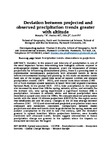Deviation between projected and observed precipitation trends greater with altitude

Date
2019-11-14Author
Subject
Metadata
Show full item recordAbstract
Variation in the amount and intensity of precipitation is one of the most important factors determining how biological systems respond to anthropogenic climate change. Moreover, given the importance of climate projections for influencing (inter)national policy, there is a pressing need to contextualise contemporary projections with observed trends to better informenvironmental strategy and planning. In this study,we examine trends fromone of the longest paired time series of upland (>300 m a.s.l.) and lowland precipitation records (1879-2012), and shorter-term obser - vations (1961-2015) from multiple upland locations in southwestern (SW) England (Dartmoor National Park). In the period 1879-2012, total precipitation at the upland site increased by more than 10% for spring, autumn, winter and annually; at the lowland site, only spring experienced a significant increase (8%) in precipitation. Increases in autumn, winter and annual precipitation were recorded at upland sites since the 1960s.We compare observed precipitation trends with the latest UK climate projections (UKCP18) for the region across 2 timeframes (60 and 90 yr). Changes in the 30 yr average between reference (1981-2010) and observed and projected precipitation totals were compared and deviations calculated. Comparisons between model projections and observed trends show large deviations for spring, summer and autumn precipitation in the mid- to late 21st century, with the deviation greatest in upland localities. However, winter projections were broadly consistent with observed trends. Our results suggest that uncertainties in future precipitation change are greatest in the uplands, where the impacts on ecosystem services are the largest.
Publisher
Journal
Volume
Issue
Pagination
Recommended, similar items
The following license files are associated with this item:

